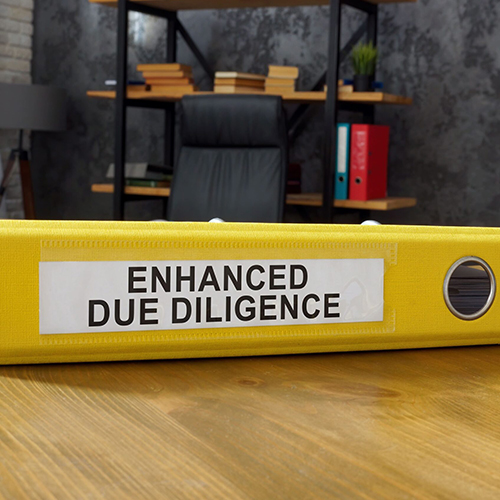Enhanced Due Diligence (EDD) is a comprehensive set of KYC/AML procedures that financial institutions follow to assess and manage risks associated with high-risk customers. EDD goes beyond standard due diligence, providing a deeper understanding of a customer's background, financial activities, and potential risks. It is crucial for compliance, preventing financial crime, and safeguarding reputations.
At its core, Enhanced Due Diligence is a comprehensive set of KYC/AML procedures that banks and financial institutions follow to assess and manage the risks associated with high-risk customers.
It goes beyond the standard due diligence (SDD) checks and goes deeper into a customer’s background, financial activities, and the risk they pose to the financial institution.
Importance of Enhanced Due Diligence
In an era where financial transactions can cross borders with the click of a button, the potential for abuse has escalated exponentially.
Regulatory bodies worldwide are also tightening their grip and imposing stringent compliance requirements with hefty penalties for non-compliance.
In this context, EDD emerges as a critical line of defense. EDD is the highest level of due diligence a bank or financial institution can do to identify and mitigate the risks associated with high-risk customers or high-net-worth businesses that engage in large and complex transactions.
EDD helps banks and financial institutions to achieve the following:
- Understand and mitigate risks that a high-risk customer poses
- Remain compliant with laws like the Bank Secrecy Act (BSA), the USA PATRIOT Act, and international guidelines set by the Financial Action Task Force (FATF).
- Prevent financial crime and safeguard their reputation.
When is Enhanced Due Diligence Required?
EDD is ideal for the following situations where enhanced scrutiny is necessary:
- Individuals with political influence or politically-exposed persons (PEPs)
- Clients subject to economic sanctions or based in sanctioned nations
- Businesses handling large and complex transactions
- Countries hosting terrorist groups
- Businesses in high-risk countries
- Businesses involved in anonymous transactions
- Clients receiving payments from unidentified third parties
Standard Due Diligence Vs. Enhanced Due Diligence
Standard Due Diligence (SDD) and Enhanced Due Diligence (EDD) are crucial KYC and AML compliance processes in banking and financial services. These help analyze risks, such as money laundering, fraud, and terrorist financing, posed by a customer or entity.
While Standard due diligence (SDD) involves verifying the customer’s identity and assessing their basic risk profiles, EDD conducts additional scrutiny on customers posing a higher risk of financial crime.
| Standard Due Diligence (SDD) | Enhanced Due Diligence (EDD) |
| To identify and assess customer risk in general. | To provide a deeper understanding of high-risk customers. |
| Applies to most customers with a lower risk profile. | Applied to customers presenting a higher risk, such as politically exposed persons (PEPs) or those from high-risk countries. |
| Basic information: name, address, date of birth, etc. | Detailed information: sources of wealth, the purpose of the account, financial statements, etc. |
| Relatively low; basic verification of provided information. | High; extensive verification of information, including third-party checks. |
| Standard monitoring based on transaction patterns. | More rigorous and frequent monitoring, with specific attention to any deviations from expected activity. |
| General risk assessment based on available information. | Detailed risk assessment considering a wider array of factors and potential for illicit activities. |
| Mandatory for all customers to meet baseline compliance. | Required by law for customers classified as higher risk. |
| Sufficient for most customers with standard risk levels. | Necessary for understanding and mitigating risks associated with high-risk customers. |
Components of Enhanced Due Diligence
Key components of Enhanced Due Diligence include:
1. Identifying High-Risk Customers
The first stage of the Enhanced Due Diligence (EDD) process involves the identification of high-risk customers.
A customer may be deemed high risk based on their location, profession, political exposure, or other factors that can increase the likelihood of their involvement in money laundering or terrorist financing.
The goal is to develop a comprehensive understanding of the potential risks and to implement measures to mitigate them effectively.
2. Detailed Financial Background Checks
After identifying the high-risk customers, Enhanced Due Diligence (EDD) requires some serious financial background checking. This isn’t just a quick peek at their basic info but a thorough investigation into their financial past, including details such as:
- Where does their money come from
- Who they’re in business with
- Legitimacy of their transactions
It requires checking public records and financial statements and matching customer details against global watchlists and sanctions lists.
The point is to catch any warning signs that might point to shady financial dealings or connections with individuals or entities they shouldn’t be involved with.
EDD is always tailored to the level of risk posed by a customer or transaction.
3. Understanding the Ultimate Beneficial Ownership (UBO)
UBO is a crucial aspect of Enhanced Due Diligence in banking and financial services. It involves identifying the individuals who own or control a customer entity, such as a company, parentship, or trust, and assessing any risk involved. This helps:
- Detect and prevent attempts to disguise illicit funds’ origin, avoid sanctions, or finance terrorism.
- Mitigate reputational, operational, legal, and credit risks associated with the individuals.
4. Adverse Media Screening
The process involves a systematic search and evaluation of negative news articles, reports, and publicly accessible information related to individuals or entities.
This type of screening is instrumental in identifying potential risks, encompassing financial and non-financial threats, which might not be apparent through conventional financial analysis or regulatory examinations.
5. Nature and Purpose of Business Relationships
This process thoroughly examines the reasons behind a bank or financial institution’s engagement with a client and their expected activities, transactions, and behavior patterns associated with that relationship.
Such understanding is critical for assessing risk, ensuring regulatory compliance, and safeguarding against financial crimes like money laundering, terrorist financing, and fraud.
6. Ongoing Monitoring
Keeping tabs on transactions is key, especially to make sure everything lines up with the bank’s or institution’s knowledge of the customer, their businesses, and how risky their dealings might be. A cornerstone of Enhanced Due Diligence (EDD) is this relentless vigilance over the transactions of those flagged as high risk.
This involves:
- Continuously scrutinizing transactions to detect any unusual or suspicious patterns that deviate from the customer’s normal business activities
- Advanced monitoring systems
- Use algorithms, AI, and machine learning techniques to flag transactions that may require further investigation
- Continuously monitoring to identify and mitigate any emerging risks
To dive deeper into building a robust AML system, read our blog on Building a Robust Transaction Monitoring System for AML Compliance.
Stages to Conduct Enhanced Due Diligence
Enhanced due diligence process typically involves the following stages:
1. Customer Identification Program (CIP)
The EDD process begins with a robust Customer Identification Program (CIP), which collects and verifies identifying information about the customer. This step is crucial for establishing the customer’s identity and assessing their risk profile.
2. Customer Due Diligence (CDD) and EDD Triggers
Following the CIP, institutions perform standard Customer Due Diligence (CDD) to gather basic information about the customer’s business and financial activities. If the CDD process uncovers any risk factors or if the customer falls into a predefined high-risk category, EDD triggers are activated, necessitating a deeper investigation.
3. Collecting and Analyzing Information
EDD involves collecting extensive information about the customer, including the origin of funds, the purpose of the account or transactions, and the customer’s business network. This information is analyzed in detail to understand the customer’s risk profile and to identify any potential issues that may require further scrutiny or reporting.
4. Risk Assessment
The culmination of the EDD process is a comprehensive risk assessment, which evaluates the information gathered to determine the level of risk associated with the customer or transaction. Based on this assessment, the financial institution decides on the appropriate course of action, which may include enhanced monitoring, reporting suspicious activities, or in some cases, terminating the business relationship.
AML/CFT Regulatory Landscape and Compliance Requirements for Enhanced Due Diligence
The landscape of anti-money laundering (AML) and counter-financing of terrorism (CFT) regulations for banks and financial institutions has evolved significantly in the past decades. International organizations and national regulatory bodies have developed detailed frameworks aimed at mitigating and preventing financial crimes.
Our white paper on Mitigating Financial Crime Risks in the Age of Cryptocurrency explores these regulatory challenges in a rapidly evolving risk landscape
Key among these regulatory frameworks are the recommendations from:
1. Financial Action Task Force (FATF)
The FATF’s recommendations have become a cornerstone for national laws worldwide, pushing for stringent due diligence, particularly for clients presenting a higher risk. These recommendations emphasize identifying and verifying customer identities, understanding the nature and purpose of business relationships, and conducting ongoing monitoring.
2. European Union’s Anti-Money Laundering Directives (AMLD)
These directives have progressively tightened EDD and other anti-money laundering (AML) requirements, including enhanced scrutiny for transactions involving high-risk countries and measures to identify beneficial ownership of legal entities.
3. United States Bank Secrecy Act (BSA) and PATRIOT Act
In the US, these laws require financial institutions to implement Customer Identification Programs (CIPs), conduct due diligence for accounts tied to foreign financial entities, and apply additional scrutiny to accounts owned by politically exposed persons (PEPs).
Compliance with these regulations is compulsory. Non-compliance can lead to severe repercussions, including hefty fines and damage to reputation. Through EDD, financial organizations are better equipped to detect and report suspicious transactions, thereby contributing to the global fight against the financial networks that support illegal activities, such as terrorism financing or money laundering. In doing so, institutions demonstrate their commitment to preventing financial crime.
Enhanced Due Diligence (EDD) Checklist
Implementing the EDD process could be intricate. An effective Enhanced Due Diligence process should cover these:
1. Identify and Classify High-Risk Customers
Start by classifying high-risk customers using the FATF’s risk-based approach and find which customers need EDD.
2. Collect Detailed Information
This includes personal data, business activities, and the source of funds.
3. Assess the Customer’s Risk Profile
Look at their business, geographic risks, funding, political exposure, and transaction patterns. Calculate their asset value and match it with what they reported.
4. Conduct In-Depth Financial Background Checks
Dive into their financial history, check them against watchlists, and search against public records.
5. Understand the Customer’s Business and Financial Relationships
Get a clear picture of their business dealings and partnerships.
6. Monitor Transactions Continuously
Keep an eye on their transaction history. This should be a continuous and ongoing process as they may transact later after the scrutiny that may stray away from norms.
7. Review Public and Private Information
Use databases, news outlets, and financial statements to identify sentiments for the customer or entity, and if the business has a bad reputation in the market that may carry its own risk.
8. Check Against Global Watchlists and Sanctions Lists
Make sure they’re not linked to any prohibited entities.
9. Document and Update Findings Regularly
Keep a detailed record of all findings found during the EDD process. Keep it updated as new information comes to light.
Challenges in Enhanced Due Diligence
Implementing and maintaining an effective EDD process poses several challenges. Some of these include:
1. Navigating a Balance Between Enhanced Due Diligence (EDD) and Customer Experience
Keeping customers satisfied during their onboarding with EDD could be challenging. EDD by nature is an invasive and time-consuming process. It requires clients to provide detailed personal and financial information. Any oversight can lead to frustration, delays, and potential loss of business.
2. Data Management and Privacy Concerns
The accuracy of the EDD process heavily relies on the quality of available data. In addition, managing a large volume of sensitive data and addressing privacy concerns related to data management, presents a significant challenge.
3. Identifying Ultimate Beneficial Owner (UBO)
Unraveling complex ownership structures is a complex but key component of the EDD process. It involves a detailed investigation to determine the individuals who ultimately own or control a customer entity.
4. Technological and Expertise Constraints
Not all institutions, especially small and medium financial institutions have the technology and expertise to efficiently conduct EDD.
5. Regulatory Variations
Financial institutions operating in global environments need to stay on top of evolving regulations across jurisdictions. However, this is a constant challenge as complying with these varying regulations adds complexity to the EDD process.
6. EDD Implementation Cost
The cost of implementing and maintaining an effective EDD process can be substantial. This includes costs associated with technology, hiring expertise, training the workforce, and hiring third-party services.
Learn How Anaptyss Can Help Streamline KYC/AML Program
Enhanced Due Diligence (EDD) in banking and financial services is a formidable tool in the fight against financial crimes, ensuring institutions not only comply with KYC/AML regulatory demands but also safeguard their operations.
Despite the challenges, with the right strategies, a risk-based approach, and technological support from partners like Anaptyss, navigating the KYC/AML landscape can be less daunting and more efficient.
Discover how a US-based bank flagged 100% of fraudulent transactions using machine learning in their fraud detection systems—one of the critical tools supporting EDD today.
To find out how Anaptyss can help you now, request a demo or connect with us at info@anaptyss.com


















